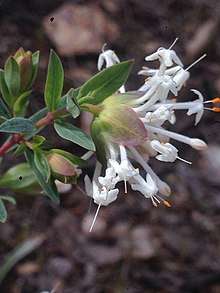Pimelea linifolia
Pimelea linifolia, commonly known as slender rice flower[2] is a common, variable shrub widespread throughout eastern Australia. It has narrow leaves arranged in opposite pairs, and usually white flowers arranged in heads of seven or more on the ends of the stems, with four lance-shaped bracts at the base of the inflorescence. The plant may be toxic to livestock.
| Slender rice flower | |
|---|---|
 | |
| Pimelea linifolia growing near Burra | |
| Scientific classification | |
| Kingdom: | Plantae |
| Clade: | Tracheophytes |
| Clade: | Angiosperms |
| Clade: | Eudicots |
| Clade: | Rosids |
| Order: | Malvales |
| Family: | Thymelaeaceae |
| Genus: | Pimelea |
| Species: | P. linifolia |
| Binomial name | |
| Pimelea linifolia | |
Description
Pimelea linifolia is a variable shrub, sometimes prostrate, sometimes growing to a height of 1.5 m (4 ft 11 in) with glabrous stems. The leaves are glabrous, narrow egg-shaped to elliptic, 3–40 mm (0.12–1.57 in) long and 1–9 mm (0.039–0.354 in) wide. The flowers are white, sometimes pink, mostly 10–20 mm (0.39–0.79 in) long. They are arranged in heads of between seven and sixty on the ends of the stems, with four, sometimes eight bracts at the base. Some flowers are bisexual and others are female, the female flowers shorter. The bracts are sessile, lance-shaped to egg-shaped, 7–17 mm (0.28–0.67 in) long and 3–11 mm (0.12–0.43 in) wide. The fruit is green and 3–5 mm (0.12–0.20 in) long.[2][3][4][5]
Taxonomy and naming
Pimelea linifolia was first formally described in 1793 by James Edward Smith from a specimen that "flowered in the greenhouse of Lord Viscount Lewisham in February 1794".[6][7]
Distribution and habitat
Slender rice flower is widespread and common in eastern Australia. It usually grows in wet forest, sometimes on the margin of rainforest. It occurs from north-east Queensland, through the eastern half of New South Wales, all but the far north-west of Victoria, the south-east of South Australia and throughout Tasmania.[2][3][4][5][8]
Ecology
This plant is suspected of being poisonous to sheep, but the evidence is inconclusive.[8]
Uses
The bark of P. linifolia can be processed into fine strong thread for catching the bogong moth (Agrotis infusa). This string, called a 'Bushman's bootlace', is produced by a traditional method that involves wetting, drying, beating and rolling the material.[9]
References
- "Pimelea linifolia". Australian Plant Census. Retrieved 2 May 2019.
- Harden, Gwen J. "Pimelea linifolia". Royal Botanic Garden Sydney. Retrieved 2 May 2019.
- Rye, Barbara L. "Pimelea linifolia". Australian Biological Resources Study, Department of the Environment and Energy, Canberra. Retrieved 2 May 2019.
- Entwisle, Tim J. "Pimelea linifolia". Royal Botanic Gardens Victoria. Retrieved 2 May 2019.
- "Pimelea linifolia". State Herbarium of South Australia. Retrieved 2 May 2019.
- "Pimelea linifolia". APNI. Retrieved 2 May 2019.
- Smith, James Edward (1793). A Specimen of the Botany of New Holland. Lambeth: J. Sowerby. pp. 31–33. Retrieved 2 May 2019.
- "Pimelea linifolia". Australian Tropical Rainforest Plants. Retrieved 2 May 2019.
- "2. Riceflower - Pimelea linifolia". Australian National Botanic Gardens. Retrieved 2 May 2019.
| Wikimedia Commons has media related to Pimelea linifolia. |
| Wikisource has original works on the topic: Pimelea linifolia |